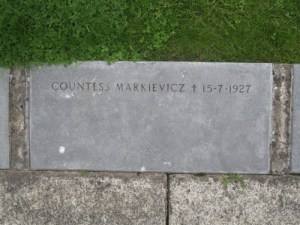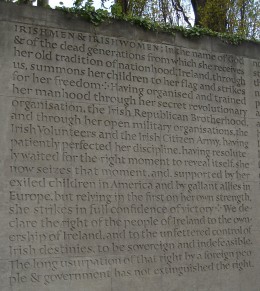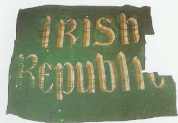Graveyards are usually associated with sadness and loss, and Glasnevin Cemetery is no exception to this. But there is one part of Glasnevin that has the power to evoke very different emotions – the Republican Plot.
It would be difficult for any person who knows that part of the history of Ireland from around 1900 to 1922 not to be moved, not to feel a sense of awe, not to be inspired by reading the headstones and markers in one small area near the main entrance. There, gathered together side by side are revolutionaries who were not afraid to dream a beautiful vision of the future for the people of Ireland, and not afraid to take on the might of the most powerful empire in the world to achieve that vision.

Countess Markievicz grave, Republican Plot, Glasnevin
Consider these names: Countess Markievicz, Maud Gonne MacBride, Cathal Brugha, Thomas Ashe, Eamon de Valera, Michael Collins, Erskine Childers, Roger Casement, Peadar Kearney, Dick McKee, Elisabeth O’Farrell, Hannah Sheehy-Skeffington, Helena Molony, Kevin Barry, Harry Boland, James Larkin. There too lie James Connolly’s wife Lillie and three of their children, Nora, Ina and Roddy. And there are more.
Imagine the Dublin of that time with these people moving about the place and developing avant-garde transformational ideas – feminism and equality, citizenship, secularism, trade unionism, socialism, republicanism and the very nature of the republic-to-be. Imagine what it must have been like to be party to their conversations and their meetings as they debated their ideas with one another and found common ground and brought more people on board, and as they started the process of moving to full-scale revolution.
Think of the number of women who were centrally involved in all of that, of the relatively young age that many of the revolutionaries were, of the number who had families depending on them, of the fact that the revolutionaries included heterosexuals, gays and lesbians among them, that they encompassed various religious persuasions and none, and were spread across the social classes from the lowest to the highest. They would fight, be prepared to die, to be free and equal citizens of the Irish Republic. All sane, rational people. Generous people.
A few miles away at Arbour Hill cemetery lie the executed leaders of the revolution. Seven of them signed their own death warrants by putting their names to the Proclamation of the Irish Republic, the others through their actions in the revolution. Their mass-grave is rarely visited. Most citizens know little of Arbour Hill or what it stands for. There is no eternal flame there, no army guard of honour, no line of school buses waiting for their young occupants to come out of the cemetery with an understanding of the sacrifice – and the prize.

1916 Leaders' Grave Arbour Hill
And what if the occupants of those graves in Arbour Hill and in Glasnevin could speak to the people of Ireland today? Would they speak of their despair at the mess we have allowed the political class to make of the country while we stood watching? Would they regret their sacrifice? Would they admonish us? No!
They would tell us that we have it in us, just as they did, to transform the future for ourselves and for generations to come. And if we asked them for a plan, a ‘road-map’, they would turn, in unison, and point to the limestone wall at the grave in Arbour Hill on which is carved the Proclamation of the Irish Republic. It is all there. The ways and the means to achieve it lie in ourselves. It is time to do it. Let’s get to work.

Proclamation Arbour Hill
